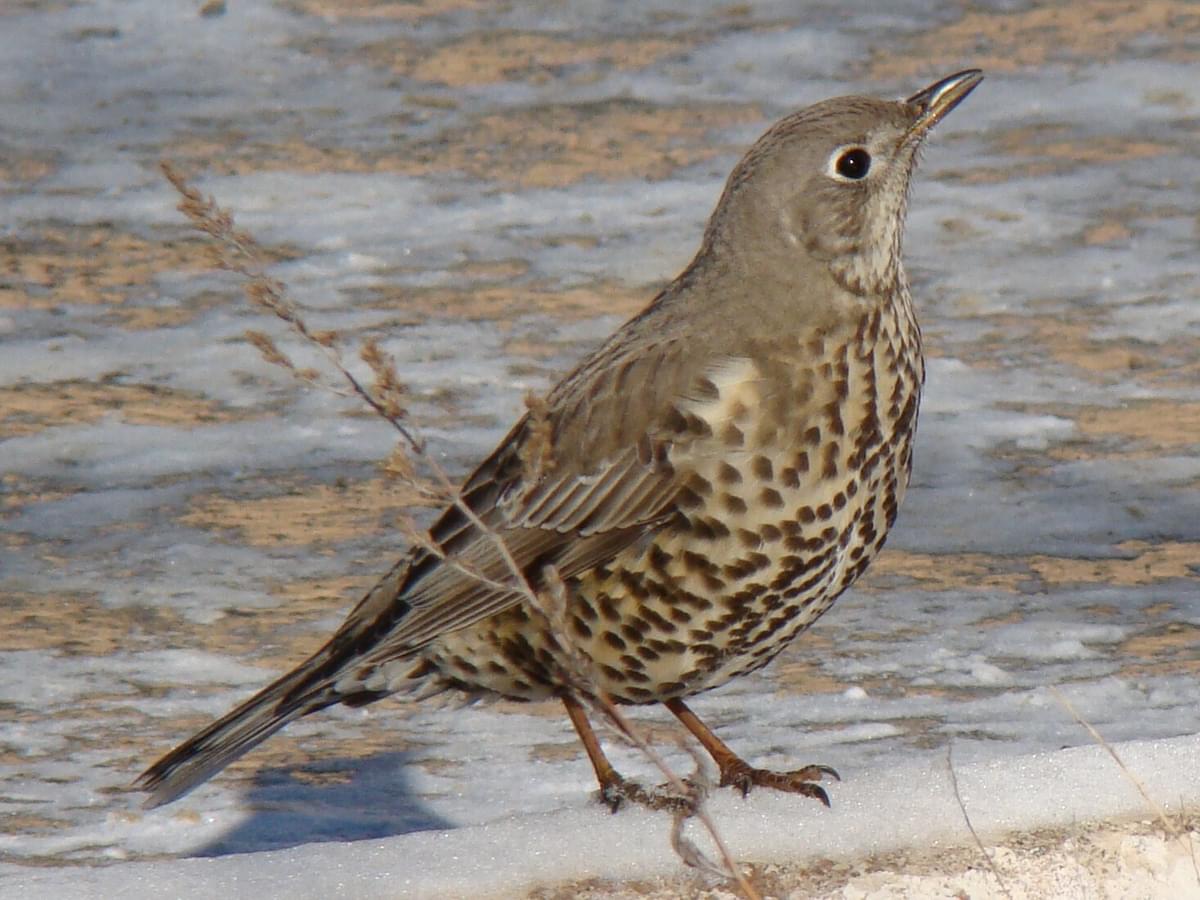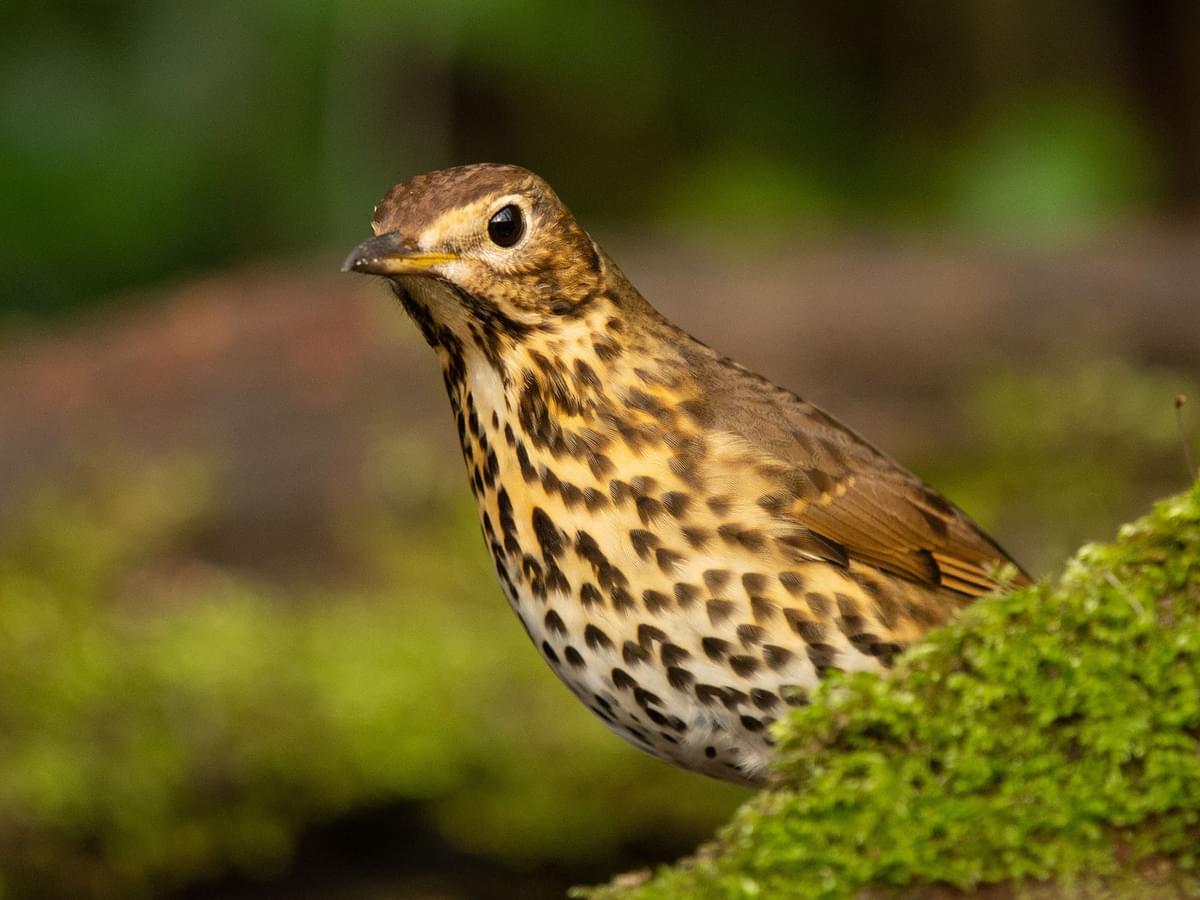Jump to Section
Mistle Thrush or Song Thrush: Spotting the Differences
Last updated: 18 December 2023

The song thrush and mistle thrush are two different species in the thrush family that are often confused by birdwatchers. This is because they both share similarities in their habits and appearance. For example, both of these birds have mottling on their breasts, and both can be found in gardens around the country feeding on lawns and in bushes with berries.
- The main differences between the two birds are that song thrushes have a rounder appearance and have lighter breasts with markings that look like upside-down hearts or arrowheads.
- Mistles thrushes appear lighter and almost grey at first glance.
- The breast of a mistle thrush also has harsher markings that look like thorns.
It's unlikely that you'll confuse these two with any other birds, but on occasion, female Blackbirds can be paler and have some streaking on the upper parts of their breasts. The best way to distinguish if it's a blackbird would be to look at the legs, as legs of a blackbird tend to be a reddish-brown or dark. Mistle and Song Thrushes both have paler coloured legs.

Mistle Thrush

Song Thrush
Comparison table
| Feature | Mistle Thrush | Song Thrush |
|---|---|---|
| Size | Larger, length around 27 cm (10.6 inches) | Smaller, length around 23 cm (9 inches) |
| Weight | Typically around 100-140 grams | Usually around 50-107 grams |
| Appearance | Pale grey-brown upperparts | Olive-brown upperparts |
| Heavily spotted underparts, spots are round and bold | Underparts with arrow-shaped spots | |
| Song | Loud, far-carrying and flute-like; less musical than Song Thrush | Melodious, repeating phrases 2-4 times, very musical |
| Habitat | Gardens, parks, woodlands, prefers more open areas | More dense habitats like thickets, hedgerows, and dense gardens |
| Distribution | Across Europe and into Asia; parts of North Africa in winter | Europe, Asia, and North Africa; migratory in northern areas |
| Breeding | Early breeder, nests in trees or shrubs, often in exposed locations | Nests in dense shrubs or hedges, more concealed |
| Diet | Omnivorous: berries, fruits, invertebrates | Mainly invertebrates, some berries and fruits |
| Behaviour | Bold and solitary, can be aggressive defending berries in winter | More secretive and less confrontational |
| Conservation Status | Generally stable but varies regionally | Widespread and common, some decline due to habitat loss |
| Identification Tips | Larger size and bolder spots | Distinctive song and smaller, more delicate appearance |
| Upright stance, often seen in open | More likely to be seen in cover, less aggressive |
About the Song Thrush
The song thrush is mainly brown all over with lighter colourings on their breasts. These breasts have darker spots, which look a bit like an arrowhead or upside-down heart. These birds are smaller in size than a blackbird and, compared to the mistle thrush, are more rounded in appearance.
The tail shares the same colour as the upperparts, and compared to the mistle thrush; the song thrush has no white outer tail feathers. Under the wing is a rusty-buff colour - this can sometimes extend down the flanks of the bird. The wing feathers have an orange-buff colour on the edges. Males and females look similar.
The song thrush produces a repetitive song with notes like ‘seoo, seoo, seoo, tidic, tidic, tidic, tew, tew, tew.’ The call is comparable to the clicking sound a bicycle wheel makes whilst spinning around.
Song Thrush
Turdus philomelos

Length:
20cm to 23cm
Wingspan:
33cm to 36cm
Weight:
65g to 100g
About the Mistle Thrush
The mistle thrush is larger than a blackbird in size and is much lighter in its colourings at first glance, and almost appear grey. The spots on the breast look more like thorns. Spots on the flanks and belly appear much more round compared to the song thrush.
The colour of the tail usually contrasts will the lighter lower back and rump. Tails also have outer edges that are paler. Under the wings is a white colour, and wingtips are white on the edges. Male and females have a similar appearance.
On the ground, mistle thrushes can usually be seen looking alert in an upright posture.
The mistle thrush song is fairly similar to the blackbird but is much shorter and has more of a gloomy tone. The call has been compared to the noise an old-fashioned football rattle makes, as it's a dry rattling sound.
Mistle Thrush
Turdus viscivorus

Length:
26cm to 29cm
Wingspan:
45cm to 50cm
Weight:
93g to 167g
Which is the most common?
The most common between the two is the song thrush. This is because the song thrush has an estimated breeding population of approximately 1 million. The mistle thrush, on the other hand, is estimated around a fifth of this figure.
So statistically, more often than not, you'll be looking at a song thrush in your garden.

